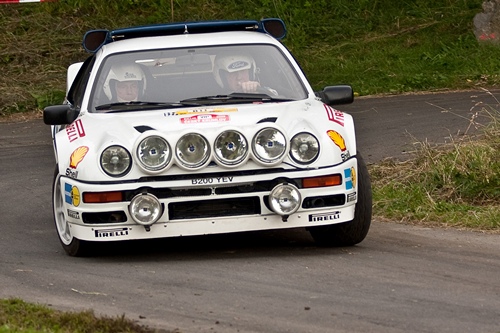Background
The Ford RS200 was Ford’s second attempt at building a Group B rally car. Their first attempt was based upon the MK3 Escort converted to rear wheel drive and powered by a 1.8ltr BDT engine pushing 350BHP in full works trim. Fortunately for RS200 fans, it quickly became obvious to Ford that 4 wheel drive was most definitely the way forward and the RS1700T was consigned to history, although its engine was recycled into the RS200.
The RS200 was a brand new ground up design, exploiting the freedom available to manufacturers under Group B rules and for Ford this resulted in the road car being an offspring of the rally car rather than the other way round. The car was an amalgamation of talents, including design company Ghia (Body design) and Formula One designer Tony Southgate (Chassis design) and Ford’s own John Wheeler, himself a Formula One engineer. It featured a plastic/fibreglass composite body which was built on behalf of Ford by Reliant, a company well known for its expertise in producing fibreglass bodies in the form of the Reliant Robin.
Without needing to compromise balance and handling for cabin space, the designers mounted the transmission at the front of the car, but this required that power from the mid mounted engine to go first up to the front wheels and then be run back again to the rear, creating a complex drive train setup. In terms of suspension each corner featured double wishbones equipped with twin dampers aiding handling and helping to give the car what was often regarded as being the best balanced platform of any of the Group B rally cars.
This car
Is a genuine works RS200, its competition history began in the hands of Stig Blomqvest on the 1986 Swedish Rally where it unfortunately retired due to engine problems. It's next event was
the ill fated Portuguese Rally which saw the withdrawal of all factory teams from the event after a number of spectators were killed after Joaquim Santo's RS200 left the road and crashed into them.
The car then passed into the hands of Mark Lovell who used it on the Circuit of Ireland where it finished fourth overall.
The car was then withdrawn from the world rally scene and purchased by Thor Holm who campaigned it in various specs in the European Rallycross series before being converted in 1988 to compete in the European Hill Climb Championship, which culminated in an attack of the famous Pikes Peak Hill Climb in the US.
Technical
Engine : four-cylinder, in-line, longitudinally mounted in the middle of the car, twin overhead camshafts, four valves per cylinder, 475 bhp, 1,803cc
Induction : Ford electronic fuel injection, Garrett turbocharger
Body : 2-door composite and aluminium monocoque with tubular steel extensions front and rear, fibreglass doors and body panels
Suspension Front : double wishbones, twin coil springs and telescopic dampers, and anti-roll bar
Suspension Rear : double wishbones, twin coil springs and telescopic dampers, and anti-roll bar
Transmission : twin plate clutch, five speed gearbox mounted at the front with the centre differential and driving all four wheels
Weight : 1,080 kg

